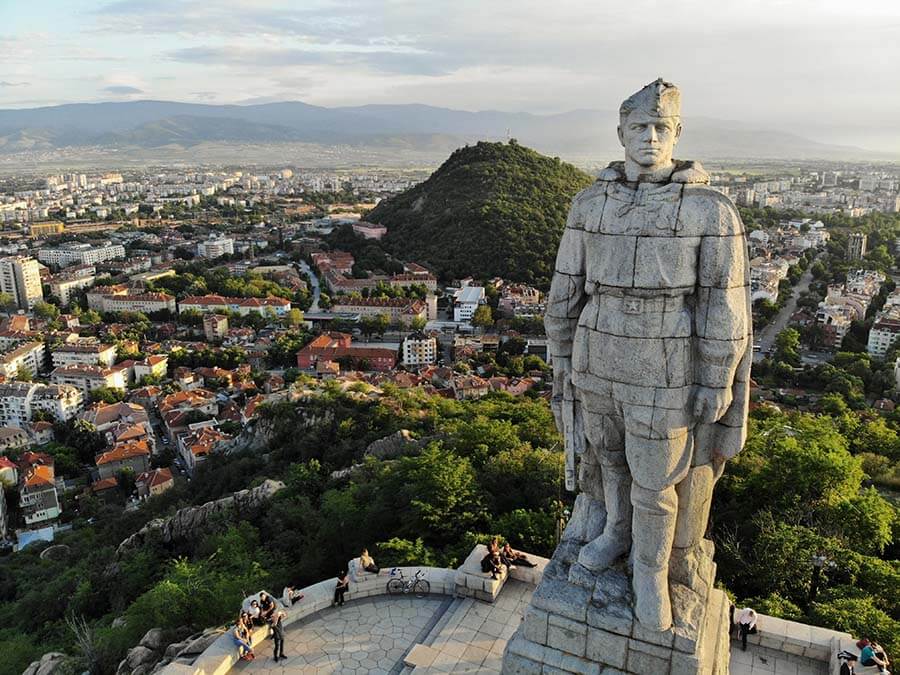The Alyosha Monument is one of the most famous military monuments in Eastern Europe. The story of the soldier Alexei Skurlatov, who became the prototype of the monument, can be heard in the song "Alyosha" of the same name. Until 1989, it was the anthem of Plovdiv, and the monument itself is still the hallmark of the city.
Description
The monument is located in Plovdiv on the Bunardzhik hill (it is also called the "Liberators' Hill"). At the same height, in 1881, under Alexander II, a composition was delivered to Russian soldiers who defended Bulgaria from Turkish troops. Thus, on Bunardzhik one can trace the history of the relationship between the Bulgarian and Russian people through time.
- The monument "Alyosha" is located at the very top of Bunardzhik. The height of the hill is 108 m, 100 steps lead to the pedestal. The road goes through a green flowering park and leads to an observation deck overlooking Plovdiv.
- In different sources, the size of the monument is different. In fact, its height is 17.3 meters.
- Figure "Alyosha" - 10, 80 m, he looks to the East. In his hands is a PPSh (Shpagin submachine gun), the muzzle of which is directed downwards. This weapon was the main one in the Russian army during the Second World War.
- The pedestal on which the figure stands is about 6 m. It is decorated with two bas-reliefs depicting war and victory.
- The monument is located in such a way that it can be seen from almost anywhere in Plovdiv.




Bunardzhik Hill has a long history. Back in the 3-4 century BC. in the days of Ancient Greece, the figure of Hercules stood on its top, and below was the temple complex.
An ancient Greek necropolis was found on the eastern slope, which later turned into a Turkish cemetery.
History of the monument
-
1947
Residents of Plovdiv came up with a proposal to honor the memory of Russian soldiers. A Public Initiative Committee was created, which announced a competition for projects to create a monument.
-
1948
10 projects take part in the competition, but two of them attracted attention - "Victory" and "Red Bogatyr".
-
1950
The architects had a year to develop their idea. When the time came, the sculptural group "Red Bogatyr" was chosen. It consisted of three elements. Her layout in real size was installed on Bunardzhik, but then they saw that the composition was lost against the sky. So it was decided to leave only a single figure of a warrior.
-
1957
The grand opening took place on November 5th. From that day until now, people come to Alyosha to celebrate their graduation or wedding.
Soviet cosmonauts, including Yuri Gagarin, came to see the monument. It is believed that each of them planted a spruce next to the monuments. This is how the Alley of Cosmonauts appeared.
Who is the prototype of Alyosha?
Officially, the monument is dedicated to an unknown Russian soldier, but among the people it and many other military pedestals in Bulgaria are called Alyosha.
According to legend, the soldier Alexei Sergeevich Skurlatov restored the connection between Plovdiv and Sofia. During this operation, he became friends with the worker of the telephone exchange Metodi Vitanov. When the creation of the monument began, Methodi gave the architect a photograph of his friend Alyosha and the master worked on this image.
Is it true that they wanted to demolish the monument?
Unfortunately yes. At the end of the 20th century, a wave of de-Sovietization swept through Eastern Europe. For 7 years there were 3 attempts to demolish the monument:
-
In 1989
For several nights, local residents were on duty around the monument to prevent its demolition.
-
In 1993
They wanted to demolish the monument on the initiative of the mayor of Plovdiv. Public organizations stood up to protect the monument
-
In 1996
The Supreme Court of Bulgaria intervened in this matter. He ruled that the monument to the Russian soldier is a cultural heritage and cannot be dismantled.
How to get to the monument?
Buses pass next to it on routes No. 1, No. 6, No. 9, No. 26, No. 99. Also KPV and PV trains.
If you do not focus on the numbers and names of routes, any transport that passes along Ruski Boulevard or Nikola Petkov Street will do.
By private transport or taxi, you can get to the monument in about 10-15 minutes from any corner of Plovdiv.
It will not be possible to travel by car on the territory of the hill itself, since Bunardzhik is under the protection of the city government and is considered a nature reserve. It is also forbidden to walk dogs, ride a bicycle, tear plants and litter on its territory.


.jpg)






